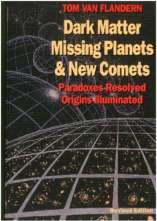Books
Books must follow sciences, and not sciences books. - Francis Bacon
Books
Letters
Overview of "Pushing Gravity: New perspectives on Le Sages theory of gravitation
Published review from "Morry on the Market"
Published review from Astronomy Book Club flyer
Published review from Australian & New Zealand Physicist
Published review from Mason-Dixon Astronomer
Published review from Meteor News
Published review from Science Frontiers Book Supplement
Published review from The Reflector
Reviews of 'Dark Matter Missing Planets & New Comets'
Where Are the Reviews In the Major Scientific Journals?
Dark Matter, Missing Planets and New Comets -- 2nd Edition (1999)
by Dr. Tom Van Flandern
Contents: Evidence against the Big Bang theory; an exposition of the Meta Model alternative for the origin and nature of the universe; deductive models for the origins of stars, planets, moons, comets, asteroids, meteoroids, rings, Sun & planet spots; the latest on the hypothetical "tenth planet" beyond Pluto; an alternative to the Oort cloud of comets and the "dirty snowball" comet model; and much more. Since the book deals primarily with observational puzzles and anomalies that don't fit conventional models, many viable alternative models are described.
Additional topics treated:
- the possibility of faster-than-light travel in forward time
- the speed of propagation of gravity
- origin of redshift and microwave radiation in the universe
- reasons why black holes don't exist
- evidence that quasars are nearby, and what they are
- about gravitational shielding
- the cause and nature of gravitation -- a complete model
- new, classical descriptions of quantum physics
- planetary breakup hypothesis as the origin of asteroids and comets
- satellites of asteroids and comets
- speculations about the origins of man
- a discussion of terrestrial and non-terrestrial pyramids
- surprising information about viewing solar and lunar eclipses
- the origin of Mercury as a moon of Venus
- the fission origin of Earth's Moon
- the origin of Martian moons and the great Martian rift "fault"
- a new model for Jupiter's Great Red Spot -- a floating impact site
- the youth of Saturn's rings
- the origin of black deposits, such as on the moon Iapetus
- the Triton-Nereid-Pluto-Charon disruption story
- a possible major planet beyond Pluto
- an exposition of Scientific Method: how to tell good models from bad
This book is written for the science-interested layman almost entirely without math. The author is a senior professional astronomer with a doctorate from Yale University. Those familiar with his nearly 100 published technical papers in the mainstream journals of astronomy will be aware that he has plenty of solid evidence that has passed peer review to back up most of his alternative models.
Much has happened in the five years since the first edition of this book was published. Many of these developments have been discussed in the pages of the Meta Research Bulletin. This bulletin contains an ongoing discussion of issues surrounding the origin and nature of things astronomical stemming from the first edition of Dark Matter, ... Four of the most relevant of these bulletin articles by the author are reproduced in new chapters of the book's 1999 (second) edition. These four are:
- "Did the Universe Have a Beginning?" [MRB 3, 25-35 (1994)]
- "A Revision of the Exploded Planet Hypothesis" [MRB 4, 33-42 (1995)]
- "New Evidence for Artificiality at Cydonia on Mars" [MRB 6, 1-15 (1997)]
- "A Revision of the Original Solar System" [MRB 6, 17-29 (1997)]
Unfortunately, the first edition sold out sooner than expected, and rapid new research developments did not leave time to rework the original 21 chapters to update them before the deadline for this new edition. Consequently, only errata of a typographical nature have been included in the original chapters. On the plus side, that will allow a more accurate assessment of how the original predictions have held up in the light of new discoveries--especially since the author has done so much scolding of mainstream scientists for continually tweaking their own models as new facts come in. An extensive Postscript summarizes the main corrections and new developments since the first edition.

